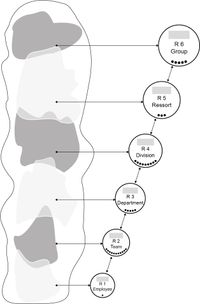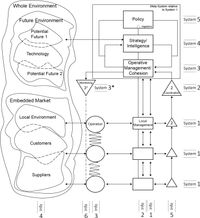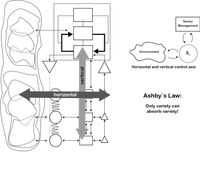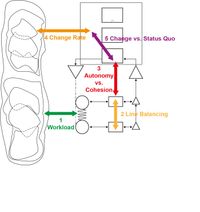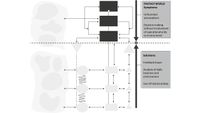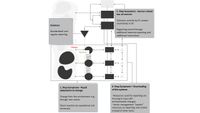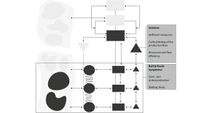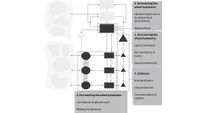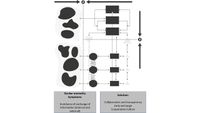The VSM Guide
I. Introduction
Overview of the Viable System Model (VSM)
The Viable System Model (VSM) is a conceptual framework to understand and design adaptive organizations. It identifies essential functions and relationships within a system, emphasizing the importance of maintaining viability, flexibility, and adaptability in complex environments. The model consists of interrelated subsystems that work together to ensure the organization's survival and effective response to external challenges. The VSM is widely used in organizational theory and practice for analyzing and improving the viability of various systems.
History of the VSM
The Viable System Model (VSM) was developed by Stafford Beer, a British cybernetician, in the late 1960s and early 1970s. Beer was influenced by cybernetics, a transdisciplinary approach to understand systems and their self-regulation. He sought to create a model that could help organizations adapt to complex and dynamic environments. Over the years, Beer continued to refine and expand upon the VSM, incorporating insights from his practical applications of the model in various organizational contexts. The VSM gained attention in many fields. Its application extended beyond business to areas like healthcare, government, and social systems for example.
Aim of the guide
This VSM guide serves as a quick and practical resource for understanding and applying the Viable System Model in organizational analysis and design. It should help to spread the powerful knowledge of management cybernetics.
II. Fundamentals of the VSM
The Conant-Ashby theorem, also known as the "Good Regulator," asserts that every effective regulator of a system must accurately model that system. In practical terms, this implies that the quality of organizational management is contingent on the fidelity of its underlying model. Conway's Law, articulated by computer scientist Melvin Conway in 1986, aligns with the Conant-Ashby theorem, stating that organizations designing systems tend to produce designs mirroring their communication structures. This connection implies that deficiencies in interdepartmental communication lead to product defects precisely at dysfunctional interfaces. Products, therefore, reflect the communication structures and underlying models of their organizations, a notion validated by a Harvard study. To understand system behavior in an organizational context, adopting a suitable model is recommended. In the realm of complex systems, where chaos is prevalent, Management Cybernetics offers a stabilizing approach. Beer introduced cybernetic principles to the business world with his VSM. His
renowned Viable System Model (VSM) serves as an alternative to hierarchical structures, drawing inspiration from the evolutionary success of the central nervous system of mammals
The Viable System Model (VSM) strives to establish equilibrium and structure within a system, presenting a fractal, self-similar arrangement (Figure 1). This pursuit involves finding a delicate balance between control and autonomy within an organization. Simultaneously, it embraces a fractal structure across all organizational levels, where a consistent organizational code effectively manages complexity and chaos, fostering order. Functioning as a foundational structure or navigational map, the VSM provides orientation. A fundamental principle guiding
this model is encapsulated by the phrase: "The purpose of the system is what it does," often abbreviated as POSIWID. In essence, an organization's raison d'être is its productive output, necessitating alignment with the production process. Given that an organization may consist of multiple viable systems, it can harbor more than one purpose, further emphasizing adaptability and diversity.
The VSM is based on Ashby's Law. The VSM is a practical application of Ashby's equilibrium formula of variety. Ashby's Law, also known as the Law of Requisite Variety, states that in order for a system to be stable, the variety (or complexity) within the system must be equal to or greater than the variety of its environment. In essence, a system needs sufficient internal complexity to effectively handle the
challenges and uncertainties presented by its external environment. It calls “Only Variety can absorb Variety“. Complexity and variety can be designed and controlled in VSM using attenuators and amplifiers. Complexity can be seen in this context as synonym of variety which describes the options for action. Complexity is not linear and develops exponentially. The unit of measurement for complexity in management cybernetics is variety. Variety can be calculated using the element-oriented formula. Using the example of five light bulbs that are
connected in series and can be switched on and off, this means that 2 to the power of 5, i.e. 2 states, on and off and five elements, resulting in 32. If you take 100 instead of five light bulbs, this means 2 to the power of 100, which results in 1,267,650,600,228,229,401,496,703,205,376. If you now imagine this calculation with people and their irrational actions, the variation that results is incalculable
Figure 1 The fractal structure
III. The static perspective on the VSM
The static facet of the VSM involves analyzing present systems using its framework. This process goes beyond system viability, addressing issues within the corporate structure, and the structural and procedural organization. The objective is to uncover cybernetic insights and pinpoint any absent elements by employing a cybernetics-oriented checklist. This serves as a foundation for the conceptual design of an enhanced system, ensuring a comprehensive consideration without the risk of overlooking crucial aspects. The VSM can be
used for design, analysis and diagnosis.
The VSM consists of six horizontal system levels (see Figure 2)
System 1 Operation
System 2 Coordination
System 3 Control & Cohesion/ Operational Management (inside & now)
System 3* Audit & Monitoring
System 4 Intelligence/ Strategic Management (outside & then)
System 5 Policy/ Normative Management
and six vertical information channels
Channel 1 Intervention & Regulation
Channel 2 Allocation of Resources
Channel 3 Operational Interrelationships
Channel 4 Interrelationships of the Environment
Channel 5 Coordination (Sympathicus) = System 2
Channel 6 Monitoring (Parasympathicus) = System 3*
Often only five systems are mentioned. System 3 and 3* are then combined or considered as one system. Both perspectives are correct.
Moreover, within the Viable System Model, there exists an algedonic channel and transducers. Algedonic signals, serving as alarm signals, convey either positive or negative messages directly into System 5. Transducers, acting as converters, establish the interface between subsystems, guaranteeing the preservation of information authenticity. The VSM is a strong homeostat. The VSM can be very well combined with other methods like lean management, scrum, OKR and others.
Figure 2 Viable System Model
System 1 – Operation
System 1 (S1) comprises three integral elements:
1. Environment,
2. Operation,
3. Management.
Together, these form the "System in focus," representing the raison d'être of the organization. This system encapsulates all primary activities of the organization, with interactivity among its three elements. Vigilance at the S1 level is paramount for the entire company. Examples of S1 include all kind of production units. It's crucial to acknowledge that organizations may encompass multiple System 1s, often representing strategic business units or product lines. When constructing a VSM, prioritizing the viability of these System 1s is imperative.
System 2 – Coordination
System 2 (S2) serves dual functions: Firstly, it acts as a communication conduit between S1 and System 3, employing standardized processes and a common language, while coordinating all S1 systems. Secondly, it functions as the institutional space for self-organization, exerting an activating or "sympathetic" influence. Examples encompass daily informal meetings, operation and production plans, Scrum/Kanban Boards, project control, production planning and control, Six Sigma, the Last Planner System, or Takt Planning and Control.
System 3 – Operational Management
System 3 (S3) manages the ongoing business of systems 1 to 3, striving to optimize operational efficiency. It allocates resources, sets performance expectations, and competes with System 4 for resources while receiving normative specifications from System 5. Instances of S3 include project leaders, team leaders, department heads, or managing directors.
System 3* – Monitoring/Audit
System 3* (S3*) functions as a review channel with an institutional absorbing or "parasympathetic" effect. Examples of this subsystem include regular management walks on the construction site or the shopfloor, engaging in conversations with foremen and workers to gain an additional perspective on the production process. It may also involve project audits, providing an objective external view of the project process. Lean tools like 5S audits or generalist layered process audits can also be situated within S3*.
System 4 – Strategic Management
System 4 (S4) is dedicated to overseeing the strategic aspects of the organization. Its primary focus involves navigating and responding to future challenges arising from the external environment. Additionally, S4 engages in resource competition with System 3 (S3). Noteworthy activities within S4 encompass strategic purchasing initiatives and the exploration and development of new business areas. This system plays a pivotal role in shaping the organization's long-term vision and ensuring its adaptability to evolving external conditions.
System 5 – Policy
System 5 (S5) embodies the identity of the organization, delving into aspects like values, norms, ethics, and culture, which are then disseminated throughout the organization. As the highest decision-making unit, it makes fundamental choices and, if needed, regulates interactions between S3 and S4. Examples include corporate values and principles that resonate across all subsystems. The board of
directors typically serves as the highest decision-making body within S5. In a family business, the owner is the normative element and the one who has the final say on decisions and can therefore absorb any remaining variety in the organization.
Below, we outline the vertical information channels:
Channel 1 – Intervention and Regulate
Understanding the central organizational specifications from S5 to S1, encompassing elements like the manuals, contracts, rulesis essential. The primary inquiry revolves around discerning expectations and adhering to established rules. Question: What is expected, and what are the rules?
Channel 2 – Allocation of Resources
Thisincludesresource allocation, encompassing taskssuch as personnel planning, resource planning, and compliance with contractual regulations. Question: What is needed? Which rules are the allocation, and how must someone justify it?
Channel 3 – Operational Interrelationships
This represents the channel of informal inner relations crucial for positive functioning, including celebrations, rituals, and private acquaintances. Essentially, it embodies the "culture of how to work." Question: What culture exists between the units?
Channel 4 – Interrelationships of external and internal environments
The interconnectedness of management and production units with various environments, such as stakeholders, the public, and politics, signifies a dynamic relationship with implications for both the present and the future. Question: How do environments affect each other, and what are the consequences for the system?
Channel 5 – Coordination (Sympathicus)
Communication of all S2 systems. Question: How do coordination and control take place?
Channel 6 – Monitoring/Audit (Parasympathicus)
Communication of all S3* systems. Question: What happens in production? Ensuring congruence between results reported to System 3 via Channel 6 and communicated results from System 1 via Channel 2 is essential for consistency and reliability in the overall communication process.
IV. The dynamic perspective on the VSM
The Viable System Model transcends a static or mechanical portrayal, resembling more a dynamic approach to comprehend the multitude of flows and their evolution within a system. Stability, in both internal and external aspects, is crucial for success. This involves aligning with Ashby's Law, operating in a suitable environment, and possessing adequate capacity (required variety) to effectively counterbalance changes with the appropriate system control across horizontal levels and vertical information channels. In Figure 3, autonomy is reflected by the variety flows on the horizontal axis, while cohesion for the entire system is influenced by the vertical axis. Senior management exercises control
over System 1 along the vertical axis, where self-control is limited. System 1 aims for autonomy, strengthening the vertical axis variety under senior management. Achieving balance between the horizontal and vertical axes is essential for satisfying Ashby's law. The variety on the horizontal axis is shaped by the number of System 1 units, their diversity, and their self-control capabilities. Meanwhile, the vertical axis's variety across the six information channels, as detailed earlier, must collectively manage the horizontal variety. Achieving harmony between these axes is pivotal for effective system operation.
Figure 3 Horizontal and Vertical Variety
When discussing variety flows, we are qualitatively addressing the organization's ability to manage the ratio between disturbance variety and system reaction within each relationship. It also pertains to the organization's capacity to cope with the inherent variety or complexity. In a dynamic VSM perspective, understanding variety in systems is akin to interpreting a weather map, with fluctuations in low and high-pressure areas that evolve over time. Indeed, in a dynamic VSM perspective, it's crucial to examine:
• Flows,
• Variety balances,
• Amplifiers and attenuators,
• Order and disorder in organizational matters.
To gain a deeper understanding of the VSM's dynamic perspective, consider these
five significant variety balances:
1. Workload
2. Line balancing
3. Autonomy vs. Cohesion
4. Change Rate
5. Change vs. Status Quo
As can be seen below in Figure 4
Figure 4 Variety Balances
The variety balances manifest concurrently with the subsystems. The evolution of
VSM subsystems typically follows this order with associated tasks:
System 1 = The Production, The Job to be done, The Purpose
System 2 = We need some Coordination, Standards, and Reporting
System 3 = We need to be efficient
System 4 = What happens in the future?
System 5 = What is our identity, vision? And why?
Workload - Variety balance 1:
Within variety balance 1, the critical relationship between production (Systems 1) and their operational environment (e.g., market, customer) is highlighted. On the production system level, questions to consider include:
- Is System 1 capable of effectively managing the existing variety (workload) from its environments?
- Can it sustain its existence in the long run?
- In adherence to the principle of subsidiarity, is System 1 equipped to handle as many tasks as possible directly?
- Does it possess the ability to self-renew and adapt to a changing environment?
- Is it financially feasible and desirable for System 1 to act relatively autonomously?
Line Balancing - Variety balance 2:
Variety balance 2 focuses on coordinating production systems through System 2. This information channel is crucial for adapting to vertical complexity. A welltuned System 2 accomplishes its tasks with 70% self-coordination, 20% active coordination, and 10% individual decisions from System 3. Unfortunately, the significance of this variety balance is often overlooked. Key questions in this context include:
- Is there adequate standardization, particularly between program and project levels?
- Are resources appropriately allocated among the various System 1 entities concerning variety balance 1?
- Is there sufficient maturity in processes and production planning?
- Silo thinking between departments may manifest here, leading to issueslike turf wars and a bunker mentality within the organization.
Autonomy versus Cohesion - Variety balance 3:
Variety balance 3 involves examining two competing balances.
1. Resource versus Performance:
In the context of examining the loop between resource supply and results within variety balance 3, consider the following questions:
- Are there sufficient resources in System 1 for expected performance?
- Is the monitoring of resource allocation and performance measurement adequately designed?
- Does the current business function optimally?
- Are synergy possibilities well-utilized?
2. Autonomy versus Cohesion:
In assessing the autonomy within variety balance 3, the focus is on whether subsystems 1 can make independent decisions and act autonomously while ensuring strategic cohesion for the entire system. Key questions in this context include:
- Is there sufficient autonomy for production to execute its tasks?
- Is there enough cohesion to enable strategic action as a unified whole?
- Are the vertical and horizontal axes in balance?
Change Rate - Variety balance 4:
Within variety balance 4, the focus is on the anticipated and unforeseen future of the entire organization. The greater the variety in these environments, the more robust system 4 must be. This channel establishes strategic planning as the framework for operational planning, though thisintegration often faces challenges in companies. To make it work, both systems 3 and 4 must be equally robust.
Relevant questions in this context include:
- Are we introducing new products without a market demand?
- Are we adapting to changes in the market and technologies?
- Are we solely relying on the production of outdated products?
- Which business units exhibit a slower rate of change than the evolving
environment?
Change versus Status Quo - Variety balance 5:
In variety balance 5, the focus is on both the organization's identity and achieving a sound decision-making balance between system 3 and system 4 for effective strategy development. This involves, for instance, the timely reallocation of human and financial resources from existing to new businesses—a challenging yet crucial task. This balance deals with processing the remaining variety that was not absorbed earlier in the system. Questions can be in this context?
- Why do we engage in our activities?
- What principles do we embody?
- Does System 5 uphold its normative responsibility?
- Is there a well-balanced decision-making process between systems 3 and 4?
- Are our strategies effectively implemented in production?
V. Archetypes of the VSM
The following is just a brief introduction to recurring problematic patterns, which are referred to as pathological archetypes and are suitable for identifying and communicating problems in systems through the viable system model.
Fantasy World
Symptoms: As shown in Figure 5, senior managers and senior executives make decisions without sound information. Neither information from the organisations environment nor from the operational base is used as a source for decisions. The perception of senior management differs greatly from reality. In a way, these managers live in a fantasy world. This can also be referred to as optmism bias.
Figure 5 Fantasy World
Solution: Senior management must be aware of Crow's Law, which states: "Don't believe what you want to believe until you know what you need to know." Assumptions based on a fantasy world do not protect the decisions made and those responsible from reality. Effective operational and strategic feedback loops, critical feedback and well-founded observations and analyses are necessary to escape from the fantasy world and validate assumptions.
Frequency: Very frequent
Control Dilemma
Symptoms: Rapid changes in the environment require a direct response from the operational systems. As can be seen in Figure 6, senior management notices unusual activities in the base and fears a loss of control. It therefore demands additional reporting and issues more instructions. The management of the operational systems now has to act on two fronts: on the one hand, to fulfill the increased requirements from the environment and, on the other, to meet the increased reporting requirements and instructions from senior management. This means pressure from outside and pressure from within. Senior management, on the other hand, neglects strategic activities because it wants to retain its supposed control over the operational systems. By intervening, senior management also denies its subsystems the autonomy they need to deal with their challenges.
Solution: Control dilemma or micromanagement requires standardized and regular reporting that stands up to scrutiny by senior management and third parties. This creates trust for both superiors and employees.
Frequency: Very common - triggered by "bottle necks"
Bottle Necks
Symptoms: According to Figure 7, classic symptoms are uncoordinated, unexpected or uncontrollable fluctuations in workload between the operational units and their environments. See also the Beer Game, which Peter Senge (1990) from MIT has made a standard part of management training. The archetype can be triggered by the control dilemma.
Figure 7 Bottle Necks
Solution: Adequate coordination mechanisms as well as bottleneck concentration, standardization and cooperative project management are effective levers for countering the archetype.
Frequency: Very common, triggers "control dilemma"
Re-Inventing the Wheel
Symptoms: In this archetype, no or insufficient standards (see Figure 8) are defined. For example in large and complex projects or organisations with a large number of departments, this leads to the wheel being reinvented several times and there are many isolated solutions. Due to the lack of standards and communication, unnecessary resources are used for activities already carried out in the subsystems and by senior management.
Solution: Uniform standards for implementation must be made binding. Implementation must be checked by means of suitable monitoring. The standards must be adapted to the unique requirements.
Frequency: Frequent - The standards must be adapted to unique requirements.
Bunker Mentality
Symptoms: The "bunker mentality" is a common problem when sudden events occur, e.g. crises. The organization closes itself off and a bunker mentality prevails both within the organization and towards the environment. Information and knowledge are neither exchanged nor accepted. Isolation takes place in order to understand the situation, reduce the amount of incoming information and regain the illusion of control. In a strategic context, this isolation is fatal for the organization.
Frequency: Very common
The following is an excerpt from an introduction to system laws. System laws can be understood and applied as practical heuristics. They provide a better understanding of the VSM and sharpen the approach as a system thinker. They are not bound to a VSM system level - the assignment serves as orientation.
Ashby's law: "Only Variety can absorb Variety" is the basis of the VSM complexity equation. Where the required variety is present, there is order and/or stability. Examples of stability: Two complete soccer teams, chess game at the beginning. Where the required variety is not present→ there is disorder and chaos.
Recursive structure of the VSM:
Principle of the unstable network: Systems with too many active, interdependent parts tend to be unstable. Example: Test run execution planning for large projects with e.g. 20 test instances. (long feedback paths, delayed reactions, too many decision levels = sluggish system behavior)
Root structuring theorem: All other factors being equal, the optimal degree of structuring a system to reduce its tendency to become unstable is the square root of the number of elements. Example: 100 elements (e.g. employees), square root of 100 = 10; formation of 10 teams.
Theorem of recursive systems: If a viable system contains a viable system, then the organizational structure must be recursive. Using the same organizational genetic code by applying the VSM, complexity is thus managed.
Self-organization principle: Systems organize themselves as follows: 1.) Creation of a new, superordinate structure of a system from previously disjointed parts. 2.) Process of self-organization within an existing system (subsystems disintegrate, form anew, change completely). Example: -United Nations: There was no superordinate authority. Often confused with self-management.
Coordination of the system 2:
Relaxation time principle: System stability is only possible if the relaxation time of the system is shorter than the mean time between disturbances. Example 1: An employee, team, department or organization is organized in such a way that a task cannot be completed "in order". Accordingly, production planning must be improved and bottlenecks avoided. Example 2: Organizational change (stable performance is disrupted by change - if changes are made too often, stability is never achieved)
System 3 ↔ System 1:
1. black box principle: It is not necessary to understand the inner workings of the black box in order to understand how it performs. Example: You don't need to understand in detail how a car drives, but you do need to know how it reacts.
2. black box principle: It is not necessary to understand the inner workings of the black box to deal with the variety it produces. Measuring complexity is not necessary. Assessing quantities and the right matching are important. Example: Project start after order placement - you start with too few staff - then readjustment takes place. The decisive factor is therefore behavior and not primarily the inner workings of the system. Complexity is deliberately ignored - the focus is on the input-output relationship or on relevant systems or relevant tasks.
Balancing loop: In the case of negative feedback (i.e. a multi-part system in which each part tends to compensate for any change in the other part), the state of equilibrium is unchanging over a wide range of initial conditions. Examples: Keeps system in balance, but can slow down and prevent change, innovation and growth. Bureaucracy is "often" designed this way. The negative feedback loop underpins homeostasis and is fundamental to understanding the stability of any system. Change works against this loop.
System 3* - Monitoring
Darkness Principle: No system can be completely captured. Systems are dynamic and change while you observe them. This must be accepted - residual uncertainty must be dealt with. Example: Black Swan
System 4 ↔ Environment:
Reinforcing loop: With positive feedback, radically different end states are possible from the same initial conditions. Is a motor in both directions (growth, innovation and bankruptcy). Caution Dependence on growth should be avoided. But also an important driver of change.
Adam's 3rd law: It states that a system built from a series of components selected on the basis that they each represent the least risky option is exposed to higher overall risk. Example: Honey bees perform a waggle dance to tell the other bees in the hive the exact direction in which to find a good pollen source, so naturally following the instructions is the lowest risk option for each individual bee. Each individual "random flight" carries a higher risk, but if all the bees were to go to the same source, the colony as a whole would be at high risk due to lack of alternatives once the source is exhausted. Flights with higher risk for the individual reduce the risk for the hive, and conversely, minimizing the risk for each individual flight increases the overall risk.
Structural coupling: The structural dynamics of the relationship between a system and its environment drive the evolutionary process. The system changes its environment and the environment changes the system. If these are in the same direction, they are structurally coupled. e.g. system changes its environment: Apple, Tesla, Google.
Agility theorem: In order to survive, the rate of change of the organization must be greater than or equal to the rate of change of the environment. ΔO ≥ ΔE. This is agile: example where it didn't work: Kodak digitization was overslept. By the time you realize it - it's often too late.
Order osmosis principle: Elements of the system flow across porous boundaries from less organized systems to more organized systems. Example: Department with poor management style of the manager (e.g. micro-controlling, choleric, unfair) loses competent and independent employees to competitors with better boundary conditions. People tend towards order.
The 3,4,5 homeostat in the VSM:
Principle of homeostasis: A system is stable if all its key variables remain within their physiological limits. It is about self-regulation, balance and ultra-stability. In the course of changes, it is about dissolving homeostasis. What are the variables for stability? Example: human body temperature
VII. Quick Modeling with the Viable System Model
When modeling a system, especially if unfamiliar, an organizational analysis becomes imperative. This involves evaluating existing organizational charts, instructions, processes, reports, manuals, and metrics. Conducting interviews across hierarchical levels, observing operations on-site, analyzing meetings, and considering organizational culture are essential steps. No specific questionnaires
are required for interviews; discussing relevant topics is sufficient. Afterward, align the identified issues with the VSM. Workshops focusing on problematic areas often yield implicit information. Graphic modeling emphasizes the creative process rather than precise drawings—grabbing a pen and paper is effective. Model drafts might resemble Picasso's work. For digital reproduction, tools like Microsoft PowerPoint or Adobe Illustrator can be used. It's crucial to understand that the VSM is not just another representation of an organizational chart; it's a management model designed to prompt the right and essential questions to create adaptable, functioning organization. The recommended modeling procedure involves following steps:
Inside and Now:
1. Clearly define the system(s) in focus and identify the recursion level.
2. Establish System 1 entities.
3. Identify the environment and complexity driver for each System 1.
4. Establish connections between System 1 and its environment, considering complexity drivers; identify amplifiers and attenuators.
5. Introduce System 2 and System 3 to the model.
Outside and then:
1. Introduce System 3, System 4, and the specific environment for System 4.
Integrate System 5 into the model.
2. Implement a completeness control to ensure all relevant components are
included.
3. Facilitate a discussion about the model, considering feedback and refining as
needed for accuracy and clarity.
Indeed, it's entirely normal to move back and forth between the steps while implementing the procedure. This iterative process allows for a valuable increase in understanding and refinement of the model.
VIII. Conclusion
Summary of the key concepts
The Viable System Model (VSM) focuses on following key concepts:
1. Six Systems: Identifies operational to strategic functions (S1 to S5).
2. Variety Balances: Ensures efficient information flow and decision-making.
3. Recursion Levels: Analyzes hierarchical, recursive structures.
4. Autonomy and Cohesion: Balances autonomy within subsystems and strategic cohesion.
5. Dynamic Perspective: Views organizations dynamically, adapting to changing environments.
These concepts make the VSM a dynamic and valuable tool for understanding and improving organizational structures functioning in a changing environment. Outlook on the importance of VSM in the future. In the future, VSM's adaptability, focus on complexity management, and strategic planning relevance will make it a crucial tool for organizations navigating dynamic landscapes, fostering holistic understanding, aiding in problem-solving, and enhancing leadership effectiveness.
Download the VSM Guide

